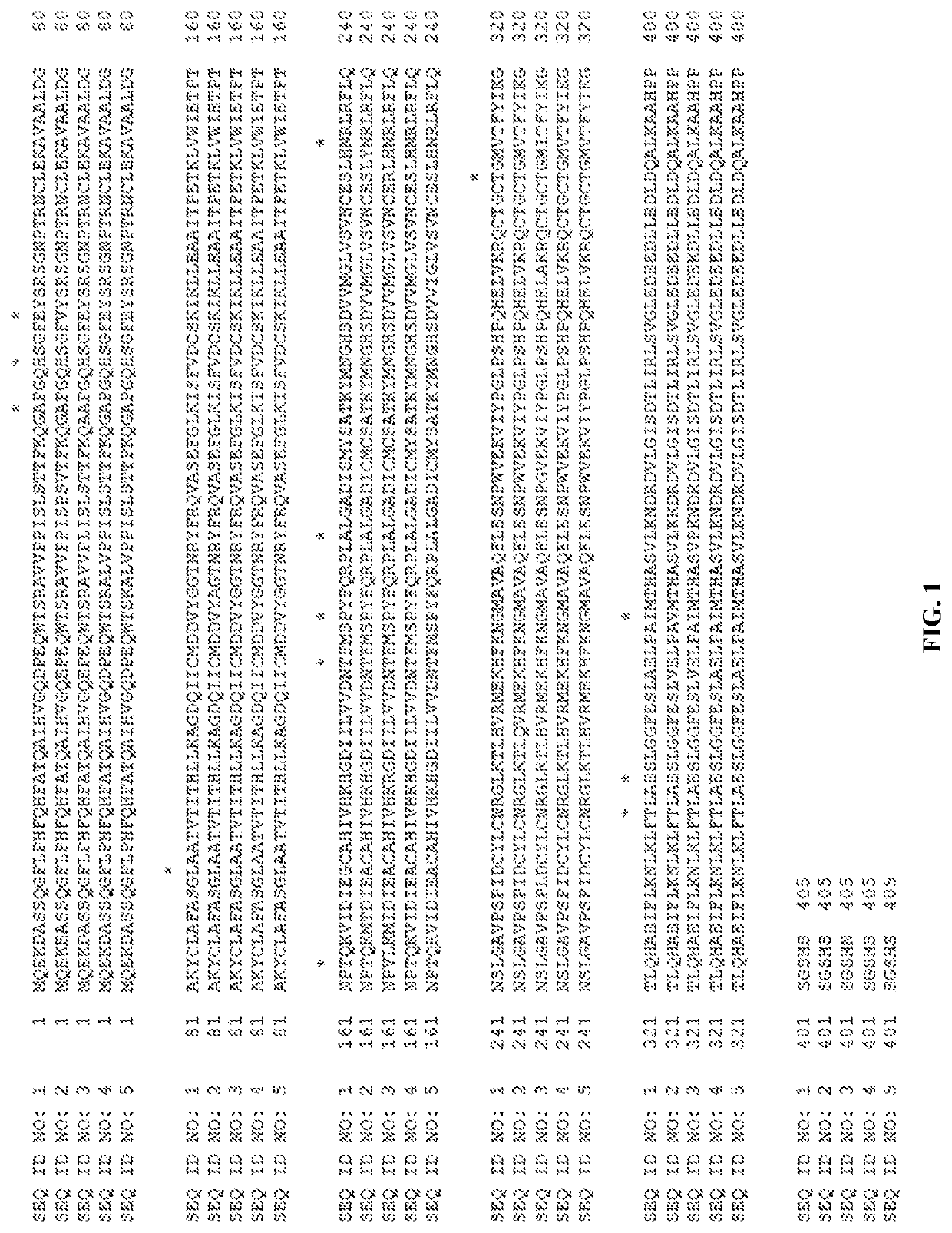Engineered primate cystine/cysteine degrading enzymes for therapeutic uses
a technology of cystine/cysteine degrading enzyme and engineered primate, which is applied in the direction of lyases, peptide/protein ingredients, drug compositions, etc., can solve the problems of limiting the use of cystine crystals and stones, and achieve efficient degradation, low km, and high catalytic activity.
- Summary
- Abstract
- Description
- Claims
- Application Information
AI Technical Summary
Benefits of technology
Problems solved by technology
Method used
Image
Examples
example 1
late Screen for Cyst(e)inease Activity
[0215]Cysteinase enzymes degrade L-cysteine to pyruvate, ammonia, and H2S, and convert L-cystine to pyruvate, ammonia, and thiocysteine (kcat / KM˜0.2 mM−1s−1 and 0.5 mM−1s−1 respectively) (thiocysteine is further nonenzymatically degraded to L-cysteine and H25). A colorimetric assay for the detection of pyruvate using 3-methyl-2-benzothiazolinone hydrazone (MBTH) (Takakura et al., 2004) was scaled to a 96-well plate format for screening small libraries and for ranking clones with the greatest cystine and / or cysteine lyase activity. This plate screen provides a facile method for picking the most active clones from the mutagenic libraries.
[0216]Single colonies containing mutagenized hCGL, or hCGL controls were picked into 96-well culture plates containing 100 μL of TB media / well containing 50 μg / mL kanamycin. These cultures were then grown at 37° C. on a plate shaker for 12 h. After cooling to 25° C., an additional 100 μL of media / well containing 5...
example 2
ion of Mutagenized Libraries of Engineered Human Cysteinase
[0217]Structural and phylogenetic analyses suggested that residues A51, E59, L91, T163, V166, T189, P193, A200, N234, T311, E339, I353, K361 and N362 could play a role in cysteinase-mediated cystine degradation. Various degenerate codon saturation mutagenesis libraries were constructed at these positions by overlap extension PCR. The resulting PCR products were digested with NcoI and EcoRI and ligated into a pET28a vector with T4 DNA ligase. The ligations were transformed directly into E. coli (BL21-DE3) and plated on LB-kanamycin plates for use in subsequent screening experiments as described in Example 1. All libraries were screened in two-fold excess of their theoretical size. Clones displaying enhanced activity compared to parental control reactions were isolated and the sequences were determined to identify the mutations.
example 3
n and Purification of Cysteinase Variants
[0218]Cysteinase variants displaying enhanced activity in the 96-well plate screens were cultured in Terrific Broth (TB) media containing 50 μg / mL kanamycin in shaker flasks at 250 rpm until reaching an OD600 of 0.5-0.6. At this point, the cultures were switched to a shaker at 25° C. and induced with 0.5 mM IPTG and allowed to express protein for an additional 12 h. Cell pellets were then collected by centrifugation and re-suspended in an IMAC buffer (10 mM NaPO4 / 10 mM imidazole / 300 mM NaCl, pH 8). After lysis by a French pressure cell, lysates were centrifuged at 20,000×g for 20 min at 4° C., and the resulting supernatant applied to a nickel IMAC column, washed with 10-20 column volumes of IMAC buffer, and then eluted with an IMAC elution buffer (50 mM NaPO4 / 250 mM imidazole / 300 mM NaCl, pH 8). Fractions containing enzyme were then incubated with 5 mM pyridoxal phosphate (PLP) for an hour at 25° C. Using a 10,000 MWCO centrifugal filter devi...
PUM
| Property | Measurement | Unit |
|---|---|---|
| volumes | aaaaa | aaaaa |
| volumes | aaaaa | aaaaa |
| pH | aaaaa | aaaaa |
Abstract
Description
Claims
Application Information
 Login to View More
Login to View More - R&D
- Intellectual Property
- Life Sciences
- Materials
- Tech Scout
- Unparalleled Data Quality
- Higher Quality Content
- 60% Fewer Hallucinations
Browse by: Latest US Patents, China's latest patents, Technical Efficacy Thesaurus, Application Domain, Technology Topic, Popular Technical Reports.
© 2025 PatSnap. All rights reserved.Legal|Privacy policy|Modern Slavery Act Transparency Statement|Sitemap|About US| Contact US: help@patsnap.com

